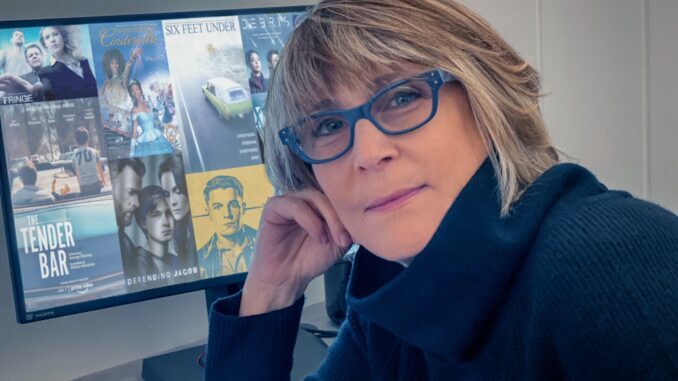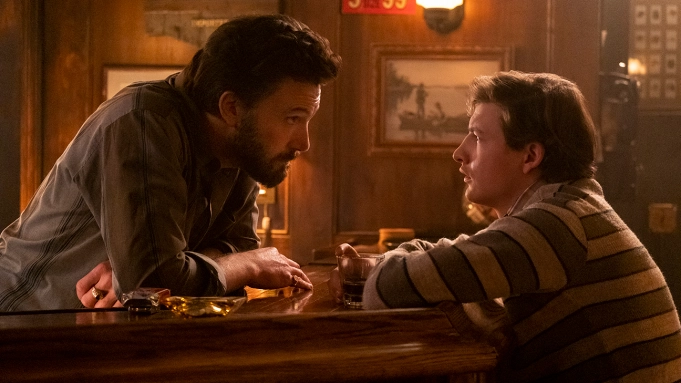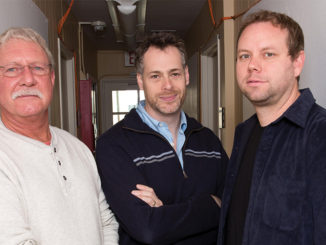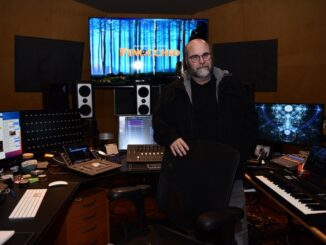
By Rob Feld
Tanya M. Swerling’s skill and deep background as an episodic television editor saw her through transformative moments in television, cutting groundbreaking one-hour dramas like “Six Feet Under” when HBO’s programming was revolutionizing the form.
She is now a part of another shift in programming expectations, cutting one of the streaming platforms’ still-early forays into feature film. “The Tender Bar” is Swerling’s second collaboration with George Clooney directing, which will be released by Amazon Studios in theaters on December 22, with a very small window before its release on Amazon Prime Video.
“The Tender Bar” is an adaptation of J.R. Moehringer’s memoir of the same name. The film opens in 1972 when nine-year-old J.R. Maguire (Daniel Ranieri, later Tye Sheridan) and his mother Dorothy (Lily Rabe) come to live with Dorothy’s family—his grandfather (Christopher Lloyd) and Uncle Charlie (Ben Affleck)—in Manhasset, Long Island. J.R. spends hours listening to the radio for the voice of his deejay father, who had abandoned them years prior, and he remains haunted by his absence. Dorothy has Ivy League ambitions for J.R., who is inspired by his autodidact Uncle Charlie to read a closet full of classic novels to become a writer, while finding comfort at the bar Charlie runs.
The family drama offered Swerling the opportunity to present nuanced performances from a multitude of perspectives within any given scene. The clear intentions of these moments combined with her delicate hand offer their nuances with humor, pathos, and without judgement, and hide the skill and years of experience behind them.
CineMontage: How did you find editing? Was there a school experience? How did you break in?

Tanya Swerling: My father is Jo Swerling, Jr.; he had a long career as a television producer and worked with Steve Cannell for many years. I had expressed an interest in the business, so when the position of post-production receptionist opened at Stephen J. Cannell Productions, nepotism got me hired. After a year answering phones and typing up ADR sheets, an apprenticeship became available. I was given that position and since I was no longer chained to a desk, I finally got to see what editing was all about. We were on film in those days, so it was much more difficult to learn the craft, as there wasn’t extra film lying around on which to practice. So, I watched folks like Casey Rohrs, Lynne and Chris Willingham, Scott Boyd, Dave Latham, the list goes on. I am still amazed by how good, how accurate they were with film. A re-print was expensive if you made too many mistakes! Guys like George Rohrs and Howard Terrill used to paper clip their cuts together! They just instinctually knew the cuts were good without even playing them through a Moviola. By the time I was ready to be an Assistant Editor, however, we had moved over to the Ediflex computer editing system. This made it very easy to learn how to be an assistant and finally gave me an opportunity to learn how to edit without fear of messing things up beyond repair. The minute I started, I knew I’d found my passion.
What was the most useful things you learned from your mentors?
TMS: As an apprentice at a very busy production company, we synced dailies reels, coded them, taped together those paper-clipped reels I mentioned, dropped off optical counts and reels to the negative cutter, got cars washed, etc. I had very little time with the editors. It wasn’t until I became an Assistant Editor that I really benefitted. I had three very important mentors as an Assistant. Scott Boyd was the Trailer Editor at SJCP back in the day—he let me play around with his black and white dupes (these were exact copies of the cut reels, but in black and white, which were much cheaper than having another color print made of a cut in progress) and he guided me on how to physically edit film and tell a story in 30 seconds. Lynne Willingham taught me about points of view and pivots in scenes. But I mostly remember how Lynne navigated a predominantly male field with grace and confidence and self-respect. She taught me how to run a cutting room as a woman: how to cultivate a space for creative equality. Finally, Casey Rohrs. I assisted Casey for the longest period. I would sit behind him, look over his shoulder and watch him cut. I just mimicked his patterns, pace, and sensibilities and that just made me a good editor! He was always encouraging me, championing me. I would not have earned the chair as early as I did if not for Casey. And he taught me one of the most important things about being an editor: be loyal to the project. The politics of this business, as you know, are tricky. But if your loyalty is to the project first, you can — mostly — avoid getting caught up in the politics. I’ve had many more influences along the way and would love to name and thank them all here, but I guess I need to … edit myself.
“Six Feet Under” was pioneering as a one-hour cable drama. What was that experience like and have you seen the process change in the years since, as they have become more common?
TMS: “Six Feet Under” was a blessing on every level. I have so much respect for Alan Ball and Alan Poul: they ran that show expertly. The cast and crew were all top-notch and of course the show was something of which to be very proud. HBO had so much trust in the Alans and gave them the freedom showrunners need to make a great show. That isn’t always the case anymore, as studios tend to get very involved in the creative process now. Honestly, for all of the innovations made over the last 20 years, the process has not changed much. Of course, there are many more distractions, so getting the work done can take a lot longer. When we would edit on “Six Feet,” the Alans would schedule editing time, show up on time, and use that time to edit. Now with texts and tweets and e-mails pinging all the time, keeping focus on the work can be a challenge.
You have worked with a wide variety of filmmakers – Alan Ball, J.J. Abrams, George Clooney to name a few. What sort of early discussions do you like to have? Is there a process you like to put into place or is it totally creator-dependent?
TMS: For me, it’s creator-dependent. Some people like to talk things through before the camera rolls and through production; some people only want to hear from me if there’s a problem. Some people like seeing first assemblies—and I’m a “versions” cutter; I love exploring the film and trying different ways in and out, shifting PsOV, messing around with pace. A few directors I’ve worked with love that option — and some people don’t want to see anything until I turn over a polished Editor’s cut. I look at it this way: I’m sort of in the customer service business, so I just have to be flexible. I pride myself on being the creative partner each type of filmmaker needs.
How has your process with Clooney evolved from “Catch-22” to “The Tender Bar”?
TMS: Since I was new to both Grant [Heslov] and George on “Catch-22,” we had to get to know each other. That was about building trust, learning their process and finding a way to make their lives easy and comfortable in the cutting room.
What I learned then was that they are so prepared when they’re shooting, that they already know what they want to do with the edit. So, I’d cut the scene as scripted, and George would watch and say, “Ok, we’re lifting all of this dialogue and I want to play most of what’s left on YoYo.” And there’s no bellyaching about it. He knows what he wants. That shooting schedule was crazy for them, so we had very little interaction during production.
With “The Tender Bar,” the first difference was that we would review assemblies of all the week’s material on the weekend. This was to give him a chance to see how his camera was doing, where his performances were sitting, etc. He would give me broad-stroke notes, but mostly this was to make sure he had gotten what he’d intended. The second difference was that we couldn’t be in the cutting room together. It was done entirely remotely. So, dealing with technical difficulties like sync delays, hinky internet connections, and sound quality was a thing.
But George was extraordinarily patient with it all. He just doesn’t sweat the small stuff. And that brings me to the third thing that I think has evolved further: trust. When things weren’t screening properly, he’d leave me with notes to do on my own. Sometimes it was a simple thing like finding a different reaction shot, and sometimes it involved me coming up with a solution for an idea he had. An example of that is the end title sequence. That was originally shot as a montage, but we already had the bowling montage, so he had the idea of using that footage for the end titles. He and I are both fans of the split screen montage (thank you Pablo Ferro!) so he just said, “Have a go!” It’s extremely freeing when you’ve earned the trust of your director; it can really inspire you.
What was the particular challenge of “The Tender Bar”?
TMS: Editing remotely. There’s nothing like being in a room with someone and vibing off their energy. Being in a virtual room doesn’t allow you to bond as much. And there’s a delay, so he’d say, “Ok, pause here,” and by the time I heard him, the scene had played a second longer. I’d say, “Is this the right spot? How ‘bout now?” A little tedious. But the film itself came together swiftly. Again, goes back to George’s prep and the fact that he has the film in his head.
Music plays a present and important role in the film. How did you work with it? Did you know the songs you would have as you cut?
TMS: George has an encyclopedic memory for music so before cameras rolled, he sent my assistant, Charles Bunn, songs to have at the ready. Our amazing Music Supervisor, Linda Cohen, added to that list. The “hero” choices pretty much made the picture. “Dancin’ in the Moonlight,” “50 Ways to Leave Your Lover,” and “Do It Again” are three examples of song placements George already had in his head. He had a few others but for budgetary reasons we had to zag. Linda and our equally great Music Editor Michael Alexander came up with alternatives for a number of those. The goal was not only to choose songs that rang nostalgic for those of us who lived through the 70’s and 80’s, but to help the audience feel the shift in time as well. The bowling montage is a good example of “pick a song!” The Isley Brothers “It’s Your Thing” was in the bin and it just felt like the right vibe: it was the first song I tried as I was cutting and thankfully it stayed in the picture.
“The Tender Bar” is a family drama with a variety perspectives and dynamics to capture during emotional family moments. Was coverage generally pre-planned or did you have leeway?
TMS: In the broad sense there was always leeway, but George is very specific when he shoots. There’s not a lot of head-scratching in the cutting room. That’s not to say it’s paint by numbers. I believe that every frame has intent, so I explore everything as I’m assembling. I typically cut three, four, five or more versions of scenes because you just never know what you’ll discover. When we reviewed, I’d present George with options, he’d pick the one that worked best for him, and we’d hone from there. Once the picture was in one piece, that’s when we really dug in and found the film. There are a few scenes that were lifted, and one scene that was written and added during production but nothing was a “tough” decision. I think the biggest deviation we made from the script was shaping Uncle Charlie — what would be the right amount of Uncle Charlie’s wisdom? How much is enough? And I believe we found the right balance. I think when you watch Ben’s performance, the arc of his character, you can’t help but smile — and like Ron Livingston’s narration says “… you want an Uncle Charlie.”
CineMontage: What do you need from a director/creator of a series as opposed to a feature film? Do your processes differ at all?
TMS: This is a complex question. It always comes down to who has the final say. At final analysis, whose vision is this going to be? If your series has multiple directors, and it is the creator/showrunner who has final cut, what I need from my director is plenty of footage so my showrunnner has what they need to make their show. For those who don’t know, TV is much more a producer’s medium. Episodic directors, their work is ultimately in the hands of the showrunner to do as they please. I have cut and recut many episodes that when the director sees them on air, they don’t even recognize the show. For better or for worse. With the feature, or event series like “Catch-22” or “Defending Jacob,” you have the benefit of basically a singular vision. And that singular vision is what I appreciate most. I have worked on shows where there are too many voices talking at once, trying to decide what the show should be; it’s chaos and the work suffers. I’d rather work on something that was made with conviction and intent and an auteur’s hand, that didn’t achieve commercial success, than a kitchen-sink-hit.
Amazon Studios will release “The Tender Bar” in Los Angeles and New York theaters on December 17, followed by a nationwide theatrical release December 22. It will premiere on Amazon Prime Video on January 7.






